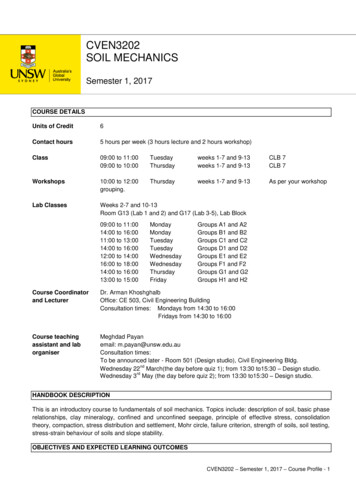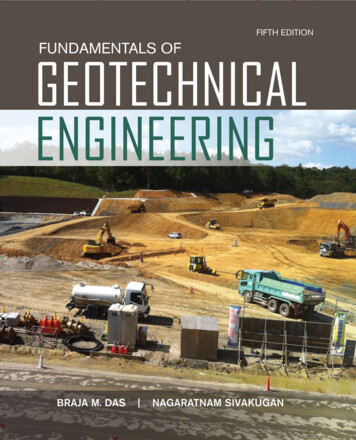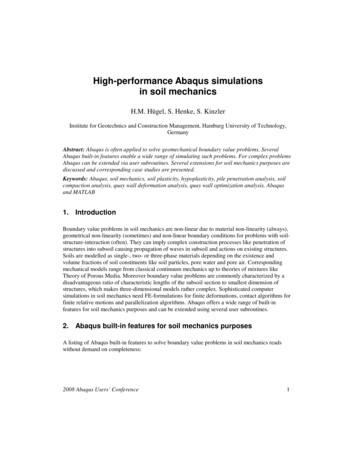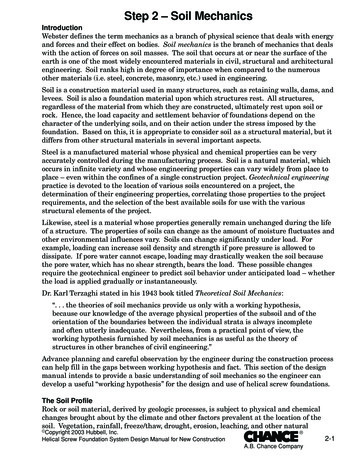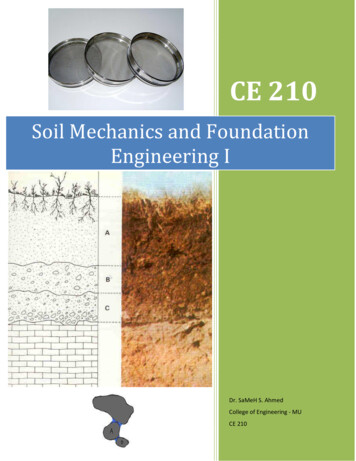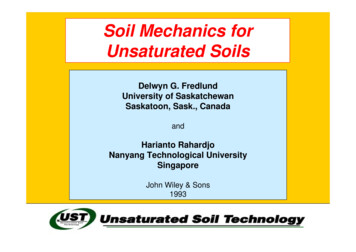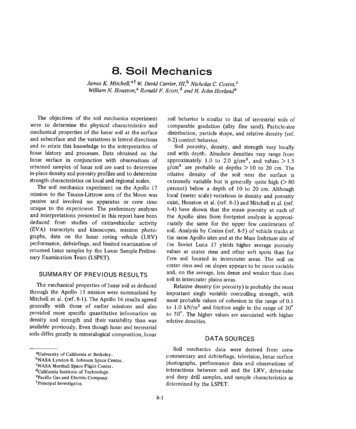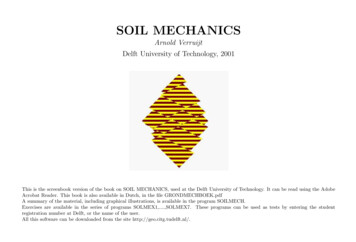
Transcription
SOIL MECHANICSArnold VerruijtDelft University of Technology, 2001This is the screenbook version of the book on SOIL MECHANICS, used at the Delft University of Technology. It can be read using the AdobeAcrobat Reader. This book is also available in Dutch, in the file GRONDMECHBOEK.pdfA summary of the material, including graphical illustrations, is available in the program SOILMECH.Exercises are available in the series of programs SOLMEX1,.,SOLMEX7. These programs can be used as tests by entering the studentregistration number at Delft, or the name of the user.All this software can be downloaded from the site http://geo.citg.tudelft.nl/.
CONTENTS1. Introduction . . . . . . . . . . . . . . . . . . . . . . . . . . . . . . . . . . . . . . . . . . . . . . . . . . . . . . . . . . . . . . . . . . . . . . . . . . . . . . . . . . . . . . . . . . . . . . . . . . . . . . . . . . . . . . . . . . . . . . . . . . 62. Classification . . . . . . . . . . . . . . . . . . . . . . . . . . . . . . . . . . . . . . . . . . . . . . . . . . . . . . . . . . . . . . . . . . . . . . . . . . . . . . . . . . . . . . . . . . . . . . . . . . . . . . . . . . . . . . . . . . . . . . . . 133. Particles, water, air . . . . . . . . . . . . . . . . . . . . . . . . . . . . . . . . . . . . . . . . . . . . . . . . . . . . . . . . . . . . . . . . . . . . . . . . . . . . . . . . . . . . . . . . . . . . . . . . . . . . . . . . . . . . . . . . . . 204. Stresses in soils . . . . . . . . . . . . . . . . . . . . . . . . . . . . . . . . . . . . . . . . . . . . . . . . . . . . . . . . . . . . . . . . . . . . . . . . . . . . . . . . . . . . . . . . . . . . . . . . . . . . . . . . . . . . . . . . . . . . . . 265. Stresses in a layer . . . . . . . . . . . . . . . . . . . . . . . . . . . . . . . . . . . . . . . . . . . . . . . . . . . . . . . . . . . . . . . . . . . . . . . . . . . . . . . . . . . . . . . . . . . . . . . . . . . . . . . . . . . . . . . . . . . . 326. Darcy’s law . . . . . . . . . . . . . . . . . . . . . . . . . . . . . . . . . . . . . . . . . . . . . . . . . . . . . . . . . . . . . . . . . . . . . . . . . . . . . . . . . . . . . . . . . . . . . . . . . . . . . . . . . . . . . . . . . . . . . . . . . . 397. Permeability . . . . . . . . . . . . . . . . . . . . . . . . . . . . . . . . . . . . . . . . . . . . . . . . . . . . . . . . . . . . . . . . . . . . . . . . . . . . . . . . . . . . . . . . . . . . . . . . . . . . . . . . . . . . . . . . . . . . . . . . . 478. Groundwater flow . . . . . . . . . . . . . . . . . . . . . . . . . . . . . . . . . . . . . . . . . . . . . . . . . . . . . . . . . . . . . . . . . . . . . . . . . . . . . . . . . . . . . . . . . . . . . . . . . . . . . . . . . . . . . . . . . . . . 529. Floatation . . . . . . . . . . . . . . . . . . . . . . . . . . . . . . . . . . . . . . . . . . . . . . . . . . . . . . . . . . . . . . . . . . . . . . . . . . . . . . . . . . . . . . . . . . . . . . . . . . . . . . . . . . . . . . . . . . . . . . . . . . . 6110. Flow net . . . . . . . . . . . . . . . . . . . . . . . . . . . . . . . . . . . . . . . . . . . . . . . . . . . . . . . . . . . . . . . . . . . . . . . . . . . . . . . . . . . . . . . . . . . . . . . . . . . . . . . . . . . . . . . . . . . . . . . . . . . . . 6711. Flow towards wells . . . . . . . . . . . . . . . . . . . . . . . . . . . . . . . . . . . . . . . . . . . . . . . . . . . . . . . . . . . . . . . . . . . . . . . . . . . . . . . . . . . . . . . . . . . . . . . . . . . . . . . . . . . . . . . . . . . 7312. Stress strain relations . . . . . . . . . . . . . . . . . . . . . . . . . . . . . . . . . . . . . . . . . . . . . . . . . . . . . . . . . . . . . . . . . . . . . . . . . . . . . . . . . . . . . . . . . . . . . . . . . . . . . . . . . . . . . . . . 7713. Tangent-moduli . . . . . . . . . . . . . . . . . . . . . . . . . . . . . . . . . . . . . . . . . . . . . . . . . . . . . . . . . . . . . . . . . . . . . . . . . . . . . . . . . . . . . . . . . . . . . . . . . . . . . . . . . . . . . . . . . . . . . . 8414. One-dimensional compression . . . . . . . . . . . . . . . . . . . . . . . . . . . . . . . . . . . . . . . . . . . . . . . . . . . . . . . . . . . . . . . . . . . . . . . . . . . . . . . . . . . . . . . . . . . . . . . . . . . . . . . . 8915. Consolidation . . . . . . . . . . . . . . . . . . . . . . . . . . . . . . . . . . . . . . . . . . . . . . . . . . . . . . . . . . . . . . . . . . . . . . . . . . . . . . . . . . . . . . . . . . . . . . . . . . . . . . . . . . . . . . . . . . . . . . . . 9616. Analytical solution . . . . . . . . . . . . . . . . . . . . . . . . . . . . . . . . . . . . . . . . . . . . . . . . . . . . . . . . . . . . . . . . . . . . . . . . . . . . . . . . . . . . . . . . . . . . . . . . . . . . . . . . . . . . . . . . . . 10217. Numerical solution . . . . . . . . . . . . . . . . . . . . . . . . . . . . . . . . . . . . . . . . . . . . . . . . . . . . . . . . . . . . . . . . . . . . . . . . . . . . . . . . . . . . . . . . . . . . . . . . . . . . . . . . . . . . . . . . . . 11018. Consolidation coefficient . . . . . . . . . . . . . . . . . . . . . . . . . . . . . . . . . . . . . . . . . . . . . . . . . . . . . . . . . . . . . . . . . . . . . . . . . . . . . . . . . . . . . . . . . . . . . . . . . . . . . . . . . . . . 1172
19. Secular effect . . . . . . . . . . . . . . . . . . . . . . . . . . . . . . . . . . . . . . . . . . . . . . . . . . . . . . . . . . . . . . . . . . . . . . . . . . . . . . . . . . . . . . . . . . . . . . . . . . . . . . . . . . . . . . . . . . . . . . . 12220. Shear strength . . . . . . . . . . . . . . . . . . . . . . . . . . . . . . . . . . . . . . . . . . . . . . . . . . . . . . . . . . . . . . . . . . . . . . . . . . . . . . . . . . . . . . . . . . . . . . . . . . . . . . . . . . . . . . . . . . . . . . 12621. Triaxial test . . . . . . . . . . . . . . . . . . . . . . . . . . . . . . . . . . . . . . . . . . . . . . . . . . . . . . . . . . . . . . . . . . . . . . . . . . . . . . . . . . . . . . . . . . . . . . . . . . . . . . . . . . . . . . . . . . . . . . . . 13422. Shear test . . . . . . . . . . . . . . . . . . . . . . . . . . . . . . . . . . . . . . . . . . . . . . . . . . . . . . . . . . . . . . . . . . . . . . . . . . . . . . . . . . . . . . . . . . . . . . . . . . . . . . . . . . . . . . . . . . . . . . . . . . 14023. Cell test . . . . . . . . . . . . . . . . . . . . . . . . . . . . . . . . . . . . . . . . . . . . . . . . . . . . . . . . . . . . . . . . . . . . . . . . . . . . . . . . . . . . . . . . . . . . . . . . . . . . . . . . . . . . . . . . . . . . . . . . . . . . 14524. Pore pressures . . . . . . . . . . . . . . . . . . . . . . . . . . . . . . . . . . . . . . . . . . . . . . . . . . . . . . . . . . . . . . . . . . . . . . . . . . . . . . . . . . . . . . . . . . . . . . . . . . . . . . . . . . . . . . . . . . . . . . 14825. Undrained behaviour of soils . . . . . . . . . . . . . . . . . . . . . . . . . . . . . . . . . . . . . . . . . . . . . . . . . . . . . . . . . . . . . . . . . . . . . . . . . . . . . . . . . . . . . . . . . . . . . . . . . . . . . . . . 15626. Stress paths . . . . . . . . . . . . . . . . . . . . . . . . . . . . . . . . . . . . . . . . . . . . . . . . . . . . . . . . . . . . . . . . . . . . . . . . . . . . . . . . . . . . . . . . . . . . . . . . . . . . . . . . . . . . . . . . . . . . . . . . 16227. Elastic stresses and deformations . . . . . . . . . . . . . . . . . . . . . . . . . . . . . . . . . . . . . . . . . . . . . . . . . . . . . . . . . . . . . . . . . . . . . . . . . . . . . . . . . . . . . . . . . . . . . . . . . . . 16828. Boussinesq . . . . . . . . . . . . . . . . . . . . . . . . . . . . . . . . . . . . . . . . . . . . . . . . . . . . . . . . . . . . . . . . . . . . . . . . . . . . . . . . . . . . . . . . . . . . . . . . . . . . . . . . . . . . . . . . . . . . . . . . . . 17229. Newmark . . . . . . . . . . . . . . . . . . . . . . . . . . . . . . . . . . . . . . . . . . . . . . . . . . . . . . . . . . . . . . . . . . . . . . . . . . . . . . . . . . . . . . . . . . . . . . . . . . . . . . . . . . . . . . . . . . . . . . . . . . . 17730. Flamant . . . . . . . . . . . . . . . . . . . . . . . . . . . . . . . . . . . . . . . . . . . . . . . . . . . . . . . . . . . . . . . . . . . . . . . . . . . . . . . . . . . . . . . . . . . . . . . . . . . . . . . . . . . . . . . . . . . . . . . . . . . . 18231. Deformation of layered soil . . . . . . . . . . . . . . . . . . . . . . . . . . . . . . . . . . . . . . . . . . . . . . . . . . . . . . . . . . . . . . . . . . . . . . . . . . . . . . . . . . . . . . . . . . . . . . . . . . . . . . . . . . 18732. Lateral stresses in soils . . . . . . . . . . . . . . . . . . . . . . . . . . . . . . . . . . . . . . . . . . . . . . . . . . . . . . . . . . . . . . . . . . . . . . . . . . . . . . . . . . . . . . . . . . . . . . . . . . . . . . . . . . . . . . 19033. Rankine . . . . . . . . . . . . . . . . . . . . . . . . . . . . . . . . . . . . . . . . . . . . . . . . . . . . . . . . . . . . . . . . . . . . . . . . . . . . . . . . . . . . . . . . . . . . . . . . . . . . . . . . . . . . . . . . . . . . . . . . . . . . 19734. Coulomb . . . . . . . . . . . . . . . . . . . . . . . . . . . . . . . . . . . . . . . . . . . . . . . . . . . . . . . . . . . . . . . . . . . . . . . . . . . . . . . . . . . . . . . . . . . . . . . . . . . . . . . . . . . . . . . . . . . . . . . . . . . 20635. Tables for lateral earth pressure . . . . . . . . . . . . . . . . . . . . . . . . . . . . . . . . . . . . . . . . . . . . . . . . . . . . . . . . . . . . . . . . . . . . . . . . . . . . . . . . . . . . . . . . . . . . . . . . . . . . . 21236. Sheet pile walls . . . . . . . . . . . . . . . . . . . . . . . . . . . . . . . . . . . . . . . . . . . . . . . . . . . . . . . . . . . . . . . . . . . . . . . . . . . . . . . . . . . . . . . . . . . . . . . . . . . . . . . . . . . . . . . . . . . . . 21937. Blum . . . . . . . . . . . . . . . . . . . . . . . . . . . . . . . . . . . . . . . . . . . . . . . . . . . . . . . . . . . . . . . . . . . . . . . . . . . . . . . . . . . . . . . . . . . . . . . . . . . . . . . . . . . . . . . . . . . . . . . . . . . . . . . 22938. Sheet pile wall in layered soil . . . . . . . . . . . . . . . . . . . . . . . . . . . . . . . . . . . . . . . . . . . . . . . . . . . . . . . . . . . . . . . . . . . . . . . . . . . . . . . . . . . . . . . . . . . . . . . . . . . . . . . 23639. Limit analysis . . . . . . . . . . . . . . . . . . . . . . . . . . . . . . . . . . . . . . . . . . . . . . . . . . . . . . . . . . . . . . . . . . . . . . . . . . . . . . . . . . . . . . . . . . . . . . . . . . . . . . . . . . . . . . . . . . . . . . 24140. Strip footing . . . . . . . . . . . . . . . . . . . . . . . . . . . . . . . . . . . . . . . . . . . . . . . . . . . . . . . . . . . . . . . . . . . . . . . . . . . . . . . . . . . . . . . . . . . . . . . . . . . . . . . . . . . . . . . . . . . . . . . . 24441. Prandtl . . . . . . . . . . . . . . . . . . . . . . . . . . . . . . . . . . . . . . . . . . . . . . . . . . . . . . . . . . . . . . . . . . . . . . . . . . . . . . . . . . . . . . . . . . . . . . . . . . . . . . . . . . . . . . . . . . . . . . . . . . . . . 25042. Limit theorems for frictional materials . . . . . . . . . . . . . . . . . . . . . . . . . . . . . . . . . . . . . . . . . . . . . . . . . . . . . . . . . . . . . . . . . . . . . . . . . . . . . . . . . . . . . . . . . . . . . . 25543. Brinch Hansen . . . . . . . . . . . . . . . . . . . . . . . . . . . . . . . . . . . . . . . . . . . . . . . . . . . . . . . . . . . . . . . . . . . . . . . . . . . . . . . . . . . . . . . . . . . . . . . . . . . . . . . . . . . . . . . . . . . . . . 25844. Vertical slope in cohesive material . . . . . . . . . . . . . . . . . . . . . . . . . . . . . . . . . . . . . . . . . . . . . . . . . . . . . . . . . . . . . . . . . . . . . . . . . . . . . . . . . . . . . . . . . . . . . . . . . . 2653
45. Stability of infinite slope . . . . . . . . . . . . . . . . . . . . . . . . . . . . . . . . . . . . . . . . . . . . . . . . . . . . . . . . . . . . . . . . . . . . . . . . . . . . . . . . . . . . . . . . . . . . . . . . . . . . . . . . . . . . 27046. Slope stability . . . . . . . . . . . . . . . . . . . . . . . . . . . . . . . . . . . . . . . . . . . . . . . . . . . . . . . . . . . . . . . . . . . . . . . . . . . . . . . . . . . . . . . . . . . . . . . . . . . . . . . . . . . . . . . . . . . . . . 27747. Soil exploration . . . . . . . . . . . . . . . . . . . . . . . . . . . . . . . . . . . . . . . . . . . . . . . . . . . . . . . . . . . . . . . . . . . . . . . . . . . . . . . . . . . . . . . . . . . . . . . . . . . . . . . . . . . . . . . . . . . . . 28148. Model tests . . . . . . . . . . . . . . . . . . . . . . . . . . . . . . . . . . . . . . . . . . . . . . . . . . . . . . . . . . . . . . . . . . . . . . . . . . . . . . . . . . . . . . . . . . . . . . . . . . . . . . . . . . . . . . . . . . . . . . . . . 28849. Pile foundations . . . . . . . . . . . . . . . . . . . . . . . . . . . . . . . . . . . . . . . . . . . . . . . . . . . . . . . . . . . . . . . . . . . . . . . . . . . . . . . . . . . . . . . . . . . . . . . . . . . . . . . . . . . . . . . . . . . . 294Appendix A. Stress analysis . . . . . . . . . . . . . . . . . . . . . . . . . . . . . . . . . . . . . . . . . . . . . . . . . . . . . . . . . . . . . . . . . . . . . . . . . . . . . . . . . . . . . . . . . . . . . . . . . . . . . . . . . . . 300Appendix B. Theory of elasticity . . . . . . . . . . . . . . . . . . . . . . . . . . . . . . . . . . . . . . . . . . . . . . . . . . . . . . . . . . . . . . . . . . . . . . . . . . . . . . . . . . . . . . . . . . . . . . . . . . . . . . 305Appendix C. Theory of plasticity . . . . . . . . . . . . . . . . . . . . . . . . . . . . . . . . . . . . . . . . . . . . . . . . . . . . . . . . . . . . . . . . . . . . . . . . . . . . . . . . . . . . . . . . . . . . . . . . . . . . . 316Answers to problems . . . . . . . . . . . . . . . . . . . . . . . . . . . . . . . . . . . . . . . . . . . . . . . . . . . . . . . . . . . . . . . . . . . . . . . . . . . . . . . . . . . . . . . . . . . . . . . . . . . . . . . . . . . . . . . . . . . 330Literature . . . . . . . . . . . . . . . . . . . . . . . . . . . . . . . . . . . . . . . . . . . . . . . . . . . . . . . . . . . . . . . . . . . . . . . . . . . . . . . . . . . . . . . . . . . . . . . . . . . . . . . . . . . . . . . . . . . . . . . . . . . . . . 335Index . . . . . . . . . . . . . . . . . . . . . . . . . . . . . . . . . . . . . . . . . . . . . . . . . . . . . . . . . . . . . . . . . . . . . . . . . . . . . . . . . . . . . . . . . . . . . . . . . . . . . . . . . . . . . . . . . . . . . . . . . . . . . . . . . . 3364
PREFACEThis book is intended as the text for the introductory course of Soil Mechanics in the Department of Civil Engineering of the Delft University ofTechnology. It contains an introduction into the major principles and methods of soil mechanics, such as the analysis of stresses, deformations,and stability. The most important methods of determining soil parameters, in the laboratory and in situ, are also described. Some basicprinciples of applied mechanics that are frequently used are presented in Appendices. The subdivision into chapters is such that one chaptercan be treated in a single lecture, approximately.Comments of students and other users on the material in earlier versions of this book have been implemented in the present version, anderrors have been corrected. Remaining errors are the author’s responsibility, of course, and all comments will be appreciated.An important contribution to the production of the printed edition, and to this screen edition, has been the typesetting program TEX, byDonald Knuth, in the LATEXimplementation by Leslie Lamport. Most of the figures have been constructed in LATEX, using the PICTEXmacros.The logo was produced by Professor G. de Josselin de Jong, who played an important role in developing soil mechanics as a branch of science.Delft, november 2001A. Verruijt5
Chapter 1INTRODUCTION1.1The disciplineSoil mechanics is the science of equilibrium and motion of soil bodies. Here soil is understood to be the weathered material in the upper layersof the earth’s crust. The non-weathered material in this crust is denoted as rock, and its mechanics is the discipline of rock mechanics. Ingeneral the difference between soil and rock is roughly that in soils it is possible to dig a trench with simple tools such as a spade or even byhand. In rock this is impossible, it must first be splintered with heavy equipment such as a chisel, a hammer or a mechanical drilling device.The natural weathering process of rock is that in the long run the influence of sun, rain and wind it degenerates into stones. This process isstimulated by fracturing of rock bodies by freezing and thwaing of the water in small crevices in the rock. The coarse stones that are createdin mountainous areas are transported downstream by gravity, often together with water in rivers. By internal friction the stones are graduallyreduced in size, so that the material becomes gradualy finer: gravel, sand and eventually silt. In flowing rivers the material may be deposited,the coarsest material at high velocities, but the finer material only at very small velocities. This means that gravel will be found in the upperreaches of a river bed, and finer material such as sand and silt in the lower reaches.The Netherlands is located in the lower reaches of the rivers Rhine and Meuse. In general the soil consists of weathered material, mainlysand and clay. This material has been deposited in earlier times in the delta formed by the rivers. Much fine material has also been depositedby flooding of the land by the sea and the rivers. This process of sedimentation occurs in many areas in the world, such as the deltas of theNile and the rivers in India and China. In the Netherlands it has come to an end by preventing the rivers and the sea from flooding by buildingdikes. The process of land forming has thus been stopped, but subsidence continues, by slow tectonic movements. In order to compensate forthe subsidence of the land, and sea water level rise, the dikes must gradually be raised, so that they become heavier and cause more subsidence.This process will probably continue forever if the country is to be maintained.People use the land to live on, and build all sort of structures: houses, roads, bridges, etcetera. It is the task of the geotechnical engineer topredict the behaviour of the soil as a result of these human activities. The problems that arise are, for instance, the settlement of a road or arailway under the influence of its own weight and the traffic load, the margin of safety of an earth retaining structure (a dike, a quay wall or asheet pile wall), the earth pressure acting upon a tunnel or a sluice, or the allowable loads and the settlements of the foundation of a building.For all these problems soil mechanics should provide the basic knowledge.6
1.2. History1.27HistorySoil mechanics has been developed in the beginning of the 20th century. Theneed for the analysis of the behaviour of soils arose in many countries, oftenas a result of spectacular accidents, such as landslides and failures of foundations. In the Netherlands the slide of a railway embankment near Weesp, in1918 (see Figure 1.1) gave rise to the first systematic investigation in the fieldof soil mechanics, by a special commission set up by the government. Manyof the basic principles of soil mechanics were well known at that time, buttheir combination to an engineering discipline had not yet been completed.The first important contributions to soil mechanics are due to Coulomb, whopublished an important treatise on the failure of soils in 1776, and to Rankine, who published an article on the possible states of stress in soils in 1857.In 1856 Darcy published his famous work on the permeability of soils, forthe water supply of the city of Dijon. The principles of the mechanics ofcontinua, including statics and strength of materials, were also well knownin the 19th century, due to the work of Newton, Cauchy, Navier and Boussinesq. The union of all these fundamentals to a coherent discipline had towait until the 20th century. It may be mentioned that the committee toinvestigate the disaster near Weesp came to the conclusion that the waterlevels in the railway embankment had risen by sustained rainfall, and thatthe embankment’s strength was insufficient to withstand these high waterpressures.Important pioneering contributions to the development of soil mechanicswere made by Karl Terzaghi, who, among many other things, has describedhow to deal with the influence of the pressures of the pore water on thebehaviour of soils. This is an essential element of soil mechanics theory.Mistakes on this aspect often lead to large disasters, such as the slides nearFigure 1.1: Landslide near Weesp, 1918.Weesp, Aberfan (Wales) and the Teton Valey Dam disaster. In the Netherlands much pioneering work was done by Keverling Buisman, especially onthe deformation rates of clay. A stimulating factor has been the establishment of the Delft Soil Mechanics Laboratory in 1934, now namedGeoDelft. In many countries of the world there are similar institutes and consulting companies that specialize on soil mechanics. Usually theyalso deal with Foundation engineering, which is concerned with the application of soil mechanics principle to the design and the constructionof foundations in engineering practice. Soil mechanics and Foundation engineering together are often denoted as Geotechnics. A well known
81. INTRODUCTIONconsulting company in this field is Fugro, with its head office in Leidschendam, and branch offices all over the world.The international organisation in the field of geotechnics is the International Society for Soil Mechanics and Geotechnical Engineering, theISSMGE, which organizes conferences and stimulates the further development of geotechnics by setting up international study groups and bystandardization. In most countries the International Society has a national society. In the Netherlands this is the Department of Geotechnicsof the Royal Netherlands Institution of Engineers (KIvI), with about 1000 members.1.3Why Soil Mechanics ?Soil mechanics has become a distinct and separate branch of engineering mechanics because soils have a number of special properties, whichdistinguish the material from other materials. Its development has also been stimulated, of course, by the wide range of applications of soilengineering in civil engineering, as all structures require a sound foundation and should transfer its loads to the soil. The most importantspecial properties of soils will be described briefly in this chapter. In further chapters they will be treated in greater detail, concentrating on aquantitave methods of analysis.1.3.1Stiffness dependent upon stress levelMany engineering materials, such as metals, but also concrete and wood, exhibit linear stress-strain-behaviour, at least up to a certainstress level. This means that the deformations will be twice as large if the stresses are twiceas large. This property is described by Hooke’s law, and the materials are called linear elastic.Soils do not satisfy this law. For instance, in compression soil becomes gradually stiffer. At thesurface sand will slip easily through the fingers, but under a certain compressive stress it gainsan ever increasing stiffness and strength. This is mainly caused by the increase of the forces.between the individual particles, which gives the structure of particles an increasing strength. .This property is used in daily life by the packaging of coffee and other granular materials by a. .plastic envelope, and the application of vacuum inside the package. The package becomes very. .hard when the air is evacuated from it. In civil engineering the non-linear property is used to. .great advantage in a pile foundation for buildings on very soft soil, underlain by a layer of sand. . .In the sand below a thick deposit of soft clay the stress level is high, due to the weight of the.clay. This makes the sand very hard and strong, and it is possible to apply large compressive.forces to t
SOIL MECHANICS Arnold Verruijt Delft University of Technology, 2001 This is the screenbook version of the book on SOIL MECHANICS, used at the Delft University of Technology. It can be read using the Adobe Acrobat Reader. This book is also available in Dutch, in the file GRONDMECHBOEK.pdf

